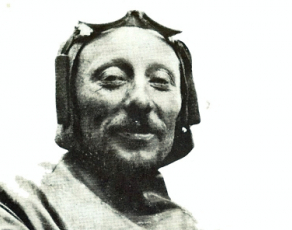
Camille Jenatzy
First man to break the 100 km/hr barrier and winner of the 1903 Gordon Bennett Race
Nationality: Belgium
Born: 1868
Died: 1913 45 Years
From uniquecarsandparts.com/au
He Had 9 Lives, But A Practical Joke Proved Fatal
CAMILLE JENATZY, BORN IN 1865, was a Belgian civil engineer turned motor manufacturer who made his competition debut in 1898 at the controls of one of his own electric vehicles, in the Chanteloup hill-climb organised by La Prance Automobile.
Although heavy rain had affected the road surface, Jenatzy made the fastest time of the day, covering the 1800-metre course at an average speed of 17 mph. Three weeks after this, on 18th December, La Prance Automobile held a second speed trial, this time over a standing-start, two-kilometre course on a deserted stretch of level road at Acheres, to the west of Paris.
Jenatzy could not take part, and the event was won by the Count Gaston de Chasseloup-Laubat driving an electric car built by Jeantaud, Jenatzy's manufacturing rival. The following day, Jenatzy wrote to Chasseloup-Laubat challenging him to a duel of speed, to be held within the month.
So, on the 17th January 1899, the two men met at Acheres. Jenatzy recorded a speed of 41.4 mph, but Chasseloup-Laubat clocked 43.7 mph, despite having the motor of his car burn out 200 yards from the finish. Ten days later, there was a return match. This time, Jenatzy reached 50mph over the flying kilometre, but Chasseloup-Laubat's motor burned out before he had even started. So his run was postponed until 4 March, when the Jeantaud achieved 57.6 mph.
The Jamais Contente
This was a phenomenal speed for the period, all the more remarkable for the fact that Chasseloup-Laubat's car was a standard touring vehicle fitted with a special body. Not in the least discouraged, Jenatzy set about building a new car with the express purpose of regaining the speed record. This was the famous Jamais Contente (Never Satisfied), a wonderful metal torpedo on wheels which was the first real purpose built racing car ever.
Its bullet-shaped body was made by Rheims & Auscher and was of partinium, a primitive aluminium alloy. To eliminate friction losses in the transmission, the electric motor was mounted directly on the driving axle. As a result, the car was fitted with the smallest wheels and tyres yet seen.
The First Vehicle To Exceed 100 Kph
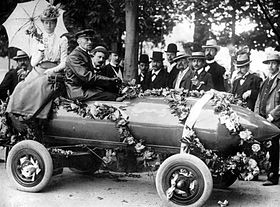 The low, streamlined effect was somewhat nullified by the fact that Jenatzy had to sit on top of the body, with only his nether regions inside the cockpit; nevertheless, after one false start, the car achieved his ambition of being the first vehicle to exceed 100 kph, his actual figure being 105 kph (65.8 mph). Not everyone was impressed, though. W. Worby Beaumont wrote in his massive Motor Vehicles and Motors: 'This is without doubt a higher speed than any other human being has ever travelled on roads, but it was only for about three-quarters of a mile that it was maintained. This vehicle was of no use in any way as a guide for any other class of vehicle'.
The low, streamlined effect was somewhat nullified by the fact that Jenatzy had to sit on top of the body, with only his nether regions inside the cockpit; nevertheless, after one false start, the car achieved his ambition of being the first vehicle to exceed 100 kph, his actual figure being 105 kph (65.8 mph). Not everyone was impressed, though. W. Worby Beaumont wrote in his massive Motor Vehicles and Motors: 'This is without doubt a higher speed than any other human being has ever travelled on roads, but it was only for about three-quarters of a mile that it was maintained. This vehicle was of no use in any way as a guide for any other class of vehicle'.
Because of the extremely limited range of the battery electric vehicle, especially if it was to have any sort of speed, Jenatzy soon turned his attention to petrol-electrics; he was also seen driving a Mors in three of the principal races of 1899 - the Tour de France, the Paris-St Malo and the Paris-Ostend - attracting public notice by his sporting effort in driving through the night in the Tour de France to make up for time lost.
In the 1900 Gordon Bennett, Jenatzy drove a Bolide petrol-electric of his own design, but lost his way and gave up in despair; the later Jenatzy petrol-electrics were equally unsuccessful, and his patent magnetic clutch, used by Pipe and Rochet-Schneider, enjoyed only a limited vogue. Jenatzy dropped out of motor sport during 1901, and his return in 1902 was hardly auspicious. During the Circuit des Ardennes, he had a terrible smash at the beginning of the second lap, the car going into one ditch and all four wheels into the other.
Le Diable Rouge
With his usual good fortune, he escaped with a few bruises. Because of his red hair and beard, and his flamboyant driving style, Jenatzy earned the nickname 'Le Diable Rouge' (The Red Devil), although there was nothing diabolic-apart from a liking for practical jokes-about his personality. In 1903, he transferred his allegiance to Mercedes, driving one of the. new 90 hp racers in the Paris-Madrid. Early in the race, he overtook 16 competitors, despite the unfavourable road conditions, and at Chatellerault, the big grey Mercedes was lying seventh. By Angoulerne, Jenatzy was third, and was being tipped as a possible winner but, at the top of the Petignac hill, he pulled up, with a mysterious fault in his engine. He eventually discovered, of all unlikely things, that the misfire was caused by a fly in the carburetter.
.
The Mercedes Team of Jenatzy, Baron de Caters and Foxhall Keene
 The literal "fly-in-the-ointment" cost him the race, as the delay had caused him to fall back into eleventh place, a position which he maintained until the race was halted at Bordeaux. Then came the Gordon Bennett, held in inland. A fire at the Mercedes factory having destroyed the special 90 hp models built for this race, the Mercedes team - Jenatzy, Baron de Caters and Foxhall Keene - used 60 hp tourers borrowed back from customers and fitted with racing bodywork.
The literal "fly-in-the-ointment" cost him the race, as the delay had caused him to fall back into eleventh place, a position which he maintained until the race was halted at Bordeaux. Then came the Gordon Bennett, held in inland. A fire at the Mercedes factory having destroyed the special 90 hp models built for this race, the Mercedes team - Jenatzy, Baron de Caters and Foxhall Keene - used 60 hp tourers borrowed back from customers and fitted with racing bodywork.
Ironically, as the two drivers chosen by Emil Jellinek (Werner and Heirony-mus) were not hochtaohlgeborene (of high birth), the Deutsche Automobil Club refused to allow them to compete, on social grounds - only gentlemen could take part in the Gordon Bennett, the honour of Germany was upheld by two Belgians and a Briton. From the second lap, Jenatzy, driving the wealthy American Clarence Gray Dinsmore's stripped Sixty Mercedes, led the field, and his victory by nearly 12 minutes brought the Gordon Bennett Cup back to Germany.
Jenatzy represented Germany in the 1904 Gordon Bennett, too, but was outclassed by Leon Thery's Richard-Brasier, and had to be content with second place. He reputedly had a narrow shave of epic proportions with a train at Wehrheim, where the line from Usingen to Frankfurt crossed the road, this was no mean achievement! A month later, for the Circuit des Ardennes, Jenatzy transferred his allegiance to the Belgian Pipe marque, but his 60 hp car only lasted two laps in this arduous race before breaking down.
The 1905 Gordon Bennett
In the 1905 Gordon Bennett, the Red Devil drove a 120 hp Mercedes, but although he made a spectacular start; the car only completed half the distance at an average speed of 40.5 mph. Having sworn to bring the Cup back to Germany whether he finished dead or alive, Jenatzy was somewhat embarrassed. Nor did he fare any better in the Circuit des Ardennes, where his Mercedes was forced out after a rim collapsed following the loss of its frail tyre.
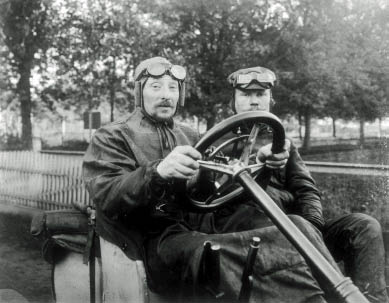 Jenatzy concluded an unsuccessful season by failing to finish in the Vanderbilt Cup, retiring on the fourth lap after dropping from second to sixth position in the preceding three rounds with the 120 hp Mercedes.
Jenatzy concluded an unsuccessful season by failing to finish in the Vanderbilt Cup, retiring on the fourth lap after dropping from second to sixth position in the preceding three rounds with the 120 hp Mercedes.
At the end of the first day's racing of the 1905 Gordon Bennett, he was lying 16th, having averaged 47.4mph, finishing well over two hours behind the leader, Szisz in a Renault. On the second day, he shared the car with Burton; the Mercedes started 16th and finished loth, the first German car to complete the course.
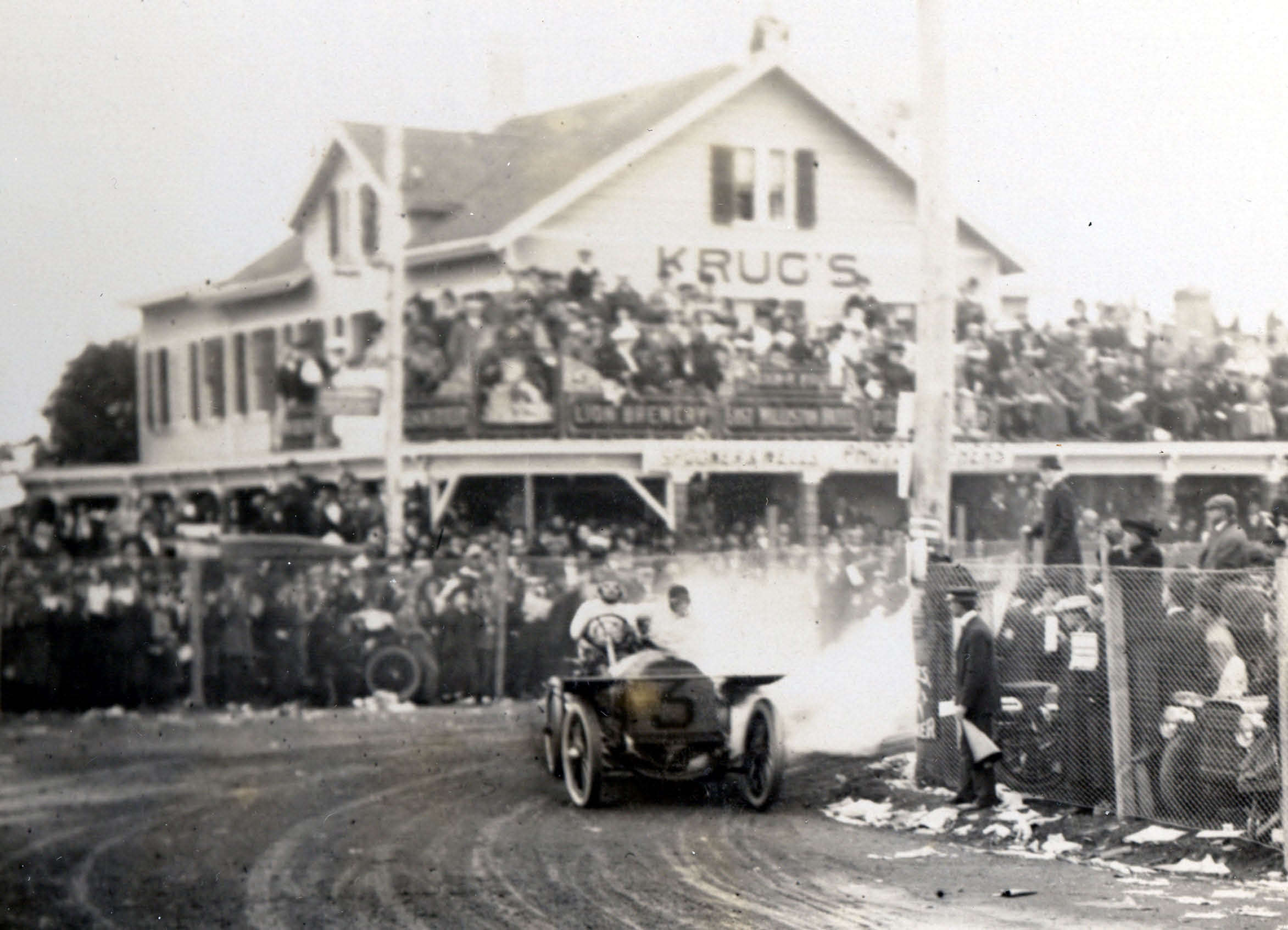 There was a tenth place for Jenatzy's Mercedes in the Circuit des Ardennes, too, while he came fifth in the Vanderbilt Cup that October. The race was stopped after he had finished, as the crowd had become uncontrollable, and hundreds of people were swarming on to the track. The next season saw jenatzy's Mercedes come 14th in the Kaiserpreis, but the combination failed to finish in the French Grand Prix, falling out on the eighth lap after working up through the field from 20th to 12th position.
There was a tenth place for Jenatzy's Mercedes in the Circuit des Ardennes, too, while he came fifth in the Vanderbilt Cup that October. The race was stopped after he had finished, as the crowd had become uncontrollable, and hundreds of people were swarming on to the track. The next season saw jenatzy's Mercedes come 14th in the Kaiserpreis, but the combination failed to finish in the French Grand Prix, falling out on the eighth lap after working up through the field from 20th to 12th position.
As in 1904, Jenatzy drove a Pipe in the Circuit des Ardennes. Again, the car failed to last the distance in the Belgian event. 1908 saw Jenatzy back with his original petrol-powered love, Mors. He drove a steady race to finish 16th at an average of 56.8 mph. However, both Mors and Jenatzy were past their prime, and this was the Red Devil's last appearance in international racing. He drove a 180 hp Mercedes in sprint and hill-climb events in 1909 and 1910, but thereafter devoted himself to his tyre company, whose factory in Brussels was one of the biggest in Belgium.
Death by Practical Joke
It was not Jenatzy's love of fast driving which caused his violent death in 1913, but his propensity for practical joking. He was entertaining a party of friends at his shooting box in the Ardennes, and one night decided to frighten them. Jenatzy crept outside, hid behind a bush, and imitated the fearsome grunt of an enraged wild boar. Whereupon one of his guests leaned out of the window and shot the supposed wild animal dead.
Fromemercedesbenz.com
Mercedes-Benz History: A Look Back At Camille Jenatzy And The 1903 Gordon Bennett Trophy
Posted June 4, 2008 At 4:00 AM CST by C. Danielson
For the history aficionados among you, Mercedes has published a press release today taking a look back at Camille Jenatzy and his 1903 Gordon Bennett Trophy win aboard a Mercedes Simplex. It was a significant race for the company, with Jenatzy's victory the first major international success for the Mercedes brand, but what makes the story even more unique is the series of events leading up to the race - most notably, a fire at DMG's Cannstatt plant that destroyed the three Simplex race cars to be used in the event.
Thankfully, three private Simplex owners lent their personal vehicles to the company for the race - one of which was piloted by Camille Jenatzy - and the rest, as they say, is history.
It's a remarkable story, and if you have a moment, I highly recommend reading it. To do so, you can find the full details of Camille Jenatzy's 1903 Gordon Bennett Trophy win as well as photos from the event in the official press release below.
Enjoy.
OFFICIAL PRESS RELEASE
The 90 hp Mercedes Simplex, Camille Jenatzy and the 1903 Gordon Bennett Trophy
It was in 1901 that Daimler-Motoren-Gesellschaft (DMG), the company founded in 1890, delivered the now legendary first 35 hp Mercedes to Emil Jellinek; designer Wilhelm Maybach then immediately set about turning his thoughts to the future. At the top of his list of priorities were a higher power output, greater operational convenience and increased reliability, which even in those days were hallmarks of Daimler vehicles. And so it came about that the engine of the Mercedes “Simplex” from 1902 already developed 40 hp (29 kW) and was easier to drive, as its name indicates.
For the year 1903, Maybach had envisaged an even more powerful engine, since DMG wanted at last to vie for the prestigious Gordon Bennett Trophy: The image boost that the company had been gaining through the Mercedes’ monumental success was to be underscored by illustrious racing victories.
The Gordon Bennett Trophy
The Gordon Bennett Trophy race, which had been established in late 1899 by James Gordon Bennett, the Paris-based American publisher and editor-in-chief of the “New York Herald”, was the most distinguished motor racing event of its day – a veritable race of the nations. This event, staged once a year, was something of a forerunner of today’s Grand Prix races. Gordon Bennett had also proposed uniform regulations for the first time. The participating vehicles, for example, were to weigh at least 400, but no more than 1,000 kilograms. They were required to be manufactured in the country they represented – right down to the last washer and bolt. This rule was strictly enforced, and the Mercedes cars felt the effects in 1903: While the Michelin tires were provided by a company manufacturing under license in Germany, this could not be said of their valves. The cars were therefore refitted with Continental tires.
The race was organized in much the same way as the traditional America’s Cup sailing regatta, the winner receiving a challenge cup that Gordon Bennett had donated to the Automobil Club de France. Each participating nation could enter up to three vehicles. The country of the winning vehicle had the honor of organizing and staging the following year’s event.
In 1902, the race was won by S. F. Edge in a Napier – an Englishman, and so the 1903 event would normally have been staged in England. However, since road races were not permitted in that country, the Automobile Club of Great Britain and Ireland had no option but to stage the race on the “emerald isle”.
The 90 hp bolide from Mercedes
In order to put up a good showing in this race especially against the strong competition from France, the Mercedes cars required an exceptional engine, which Maybach developed within a very short time on the basis of the 40 hp (29 kW) unit from the Simplex. It was provided in two “sizes” and thus in two power categories: a 9.2 liter engine officially developing 60 hp (44 kW) at 1,100 rpm – but which actually reached a good 65 hp (48 kW) – and a 12.7 liter unit developing 90 hp (66 kW) at 1,200 rpm.
These four-cylinder engines each included overhead inlet valves, lateral outlet valves and dual camshafts – a design that was also to be found in the Mercedes engines from the ensuing years. The low-voltage magneto ignition with contact points in the combustion chamber was supplemented by a high-voltage unit incorporating standard spark plugs.
A new feature were the inlet valves, which in addition to the element mechanically displaced by the camshaft also included an automatic “snifting valve” of rather adventurous design. Although these valves required highly precise matching to their doubly centered seats, they never once gave cause for complaint. The objective of their highly characteristic design was to achieve maximum filling of the cylinders.
The cooling power of the exemplary honeycomb radiator, which had proved reliable since the time of the very first Mercedes, was further increased by means of a series of fine grooves on the coolant tubes. The effective surface area was thereby increased to such an extent that the same quantity of water could be used to cool a considerably more powerful engine.
In their dimensions, the chassis and running gear corresponded to the Simplex, only that its track width was somewhat narrower; this also made for a more slender body. The decidedly sporty Simplex bodies were produced with the accustomed reliability by the Christian Auer company in Cannstatt. The new cars’ most salient feature was their front section with its characteristically formed roof-shaped radiator top and a correspondingly styled aluminum hood. The rest of the body consisted of a bulkhead with an oil sight glass and a simple platform, on which the driver’s and passenger’s bucket seats were mounted and to the rear of which the spare wheels were strapped.
The fire at DMG’s Cannstatt plant
The Mercedes-Simplex 60 hp attracted mainly private buyers, who were able to pick up their vehicles at Untertürkheim, DMG’s as yet unfinished new plant. The three 90 hp bolides for the Gordon Bennett race were set to be loaded onto a railway wagon at the DMG plant on Seelberg hill in Cannstatt. However, their career came to an end before it had even begun: At half past two in the morning of June 10, 1903, a devastating fire broke out in the factory, destroying the production facilities along with ninety vehicles, many of which were complete – including the three race cars.
Even today, DMG’s reaction to this disaster makes quite dramatic reading in itself: 1. No workers were dismissed, with production continuing temporarily in rented workshops. 2. With dual-shift operations, construction of the new plant in Untertürkheim was expedited to such an extent that the move from Cannstatt to Untertürkheim was complete by 1904, a year ahead of schedule. 3. For the forthcoming race on July 2, 2003, DMG purchased or borrowed three of the 60 hp Mercedes Simplex cars from private owners, so it was able to participate in the event in Ireland in spite of events.
Camille Jenatzy skids his way to victory
The Mercedes cars chosen were modified for the race in record time, given a thorough check-up once more and painted white, the German racing color. DMG had won over the internationally renowned and successful Belgian Baron Pierre de Caters and the American Foxhall Keene as drivers – as well as assigning the car of the millionaire American automobile enthusiast Clarence Clay Dinsmore, who had generously made his vehicle available free of charge, to the Belgian driver Camille Jenatzy.
There was no longer sufficient time to dispatch the cars to Ireland by rail, so they were driven through France to the race circuit near Dublin under their own power, arriving safe and sound a day and a half prior to the event.
Most races at the time were staged as “city to city” events; but the 1903 Gordon Bennett Trophy race made a new departure, with two circuits 65 and 83 kilometers in length being used in alternation.
Camille Jenatzy, born in Brussels in 1868, was on the one hand a down-to-earth engineer, but on the other hand a race driver obsessed with speed. He achieved fame with his red beard and by becoming the first person to break the 100 km/h barrier – in April 1899 at the wheel of an electrically powered car by the name of “La Jamais Contente” (the never-contented).
On that cool and cloudy day, July 2, 1903, Jenatzy drove the race of his life on a track riddled with curves and bumps. At the wheel of a car that was inferior in terms of engine power – at least on paper – he commanded the field with his undaunted, spectacular driving style and by virtue of the fact that he knew just how to put the immense torque of his four-cylinder engine to best effect when accelerating out of curves. He also benefited from the relatively low weight of his Mercedes by comparison with his competitors’ vehicles.
A participant marveled: “Throughout the seemingly endless series of curves, Jenatzy kept his foot to the floor. He skidded at breakneck speed around the corners, often only narrowly missing the bordering walls in the process, as was shown by his skid marks that were everywhere to be seen. I could not imagine that he could keep up this daredevil driving style for very long.”
 But keep it up he did, unlike his two teammates; and his Mercedes bearing the number 4 was the first across the line. He had won this noteworthy race, in the face of competition from more powerful cars, at an average speed of 79.24 km/h.
But keep it up he did, unlike his two teammates; and his Mercedes bearing the number 4 was the first across the line. He had won this noteworthy race, in the face of competition from more powerful cars, at an average speed of 79.24 km/h.
This was not just a victory for Jenatzy, but above all a victory and indeed a first major international success for the Mercedes brand, which had now finally established itself in the elite of racing nations the likes of England or France – a status that the brand with the three-pointed star maintained through the amalgamation with Benz into Mercedes-Benz, and has faithfully upheld to this very day.
Copyright © 2008, Daimler AG
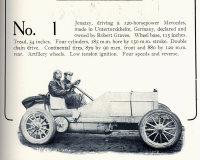

hi, how do you date the chassis of a car with the fedco plate? my fedco plate read
YYY EEE ZERO THRE ONE WWW, so the…